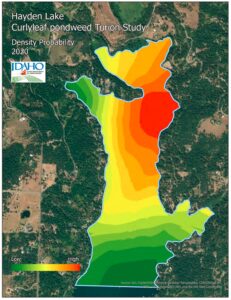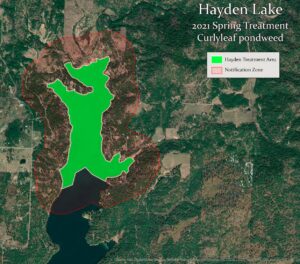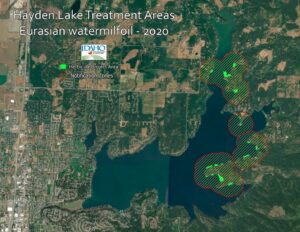Watch the video of Jeremey Varley’s presentation below.
Curly-Leaf Pondweed
Curly-Leaf Pondweed (CLP), an invasive aquatic weed, has the power to keep kids out of the water and to stop motorboats dead in their tracks. Fortunately, the Idaho State Department of Agriculture (ISDA) has implemented herbicide treatments targeting CLP in Hayden Lake since 2019. They have successfully reduced the CLP population and are on track for getting it under control. CLP begins its growth cycle in the fall. It builds strength under the cold water and ice of winter and shoots upward early in the spring before native plants have a chance to awaken. Its treatment, therefore, takes place in the spring, targeting the point in the plant’s life cycle when it is most developed but before turion production. This strategy means to ensure that no late-emerging plants pop up after the treatment and no new seeds develop before.
 2018, first-year CLP overwhelmed the North Arm; no spring treatment.
2018, first-year CLP overwhelmed the North Arm; no spring treatment.- May 2019, utilized SonarOne (Fluridone) herbicide.
- May 2020, used Galleon SC (Penoxsulam) herbicide.
- The treatment area extends from McLean’s Bay north into the Sportsman’s area and the bay north of the park.
- Turion Study, investigating the seed-potential of CLP in the North Arm:
- More, smaller turions per ponar grab in 2nd year (2020)
- In 2020, high-density area shifts toward the shore east of Sportsmans peninsula
 Clean Lakes’ contract renewed for 2021.
Clean Lakes’ contract renewed for 2021.- Same 269-acre polygon to be treated for CLP.
- Galleon SC will be used again.
- Notices will go out the week of 4/26 to Hayden Lake water rights holders (update your address with Idaho’s Department of Water Resources).
- The contractor will tentatively treat the week of May 17, pending supporting weather.
Q: What is “success” on Curly-Leaf in 5 yrs? Are you hoping to eradicate it in the N arm?
A: “Eradicate is a strong word.” As we continue the treatments, we want to deplete the concentration of viable turions in the sediment. This should bring the CLP population under control. We don’t expect to eradicate CLP from the lake fully. Success is getting the population to a level that is controllable via mechanical harvesting, and where it doesn’t hamper navigation.
Q: I’ve noticed weeds closer to the shores in the north area. Do you treat these areas or just the main channel?
A: ISDA works with Clear Lakes to designate three treatment zones – near-shore where the water is shallower, mid-range, and deeper water. The application rate varies in each zone to account for the depth of the water, drift, movement in the water, and the slope of the lake bottom. This results in an even distribution of an effective concentration across the treatment area, all the way to the shoreline.
Q: How long does it take a turion embedded in the lake bottom to become un-viable?
A: A viable turion is rigid like a pine cone. Soft, squishy turions are unlikely to germinate. Turions may remain viable for multiple seasons, but clear evidence isn’t available to pinpoint exactly how long. The Turion Study aims to gain some understanding related to that question.
Eurasian Watermilfoil
The invasive weed Eurasian watermilfoil (EWM) and its hybrids impact all parts of Hayden Lake. Heavy growth can alter aquatic ecosystems, forming dense weed mats on the surface of the water that shade-out other aquatic plants, degrade water quality, and interfere with navigation along the shoreline. EWM pops up late in the spring and tops out in July, at the height of the recreation season. Because it emerges after the CLP has topped out, this year’s spring herbicide treatment will have little effect on EWM in the North Arm.
 2019 Eurasian and Hybrid Milfoil growth in the North Arm hindered by the lengthy Fluridone treatment; new growth detected September 2020.
2019 Eurasian and Hybrid Milfoil growth in the North Arm hindered by the lengthy Fluridone treatment; new growth detected September 2020.- Late August 2020 treatment used ProcellaCOR (Florpyrauxifen-benzyl).
- ISDA treated 26.3 acres scattered along the mid-section of the lake, from O’Rourke Bay to the shoreline north of McLeans Bay.
- September 2020 diver project hand-harvested EWM from Gem Shores, McLean’s Bay and the adjacent shoreline, and Mokins Slough.
 Clean Lakes’ contract renewed for 2021.
Clean Lakes’ contract renewed for 2021.- A full littoral zone survey will take place in July. This will include all of the north arm, a thin shoreline band around the rest of the lake, plus Mokins, McLeans, and O’Rourke bays.
- Survey results will drive treatment areas.
- ProcellaCOR herbicide will be used for early treatment* in July or August. An alternative herbicide will be chosen if additional, late-season treatment is needed.
- Water use restrictions: do not water gardens, crops, trees, ornamental plants.
- Post-treatment FAS tests will assess concentrations in the water to release restrictions.
* ProcellaCOR can be used in any treatment area for only two subsequent years. It has been used once in Hayden Lake and will be used again this year.





